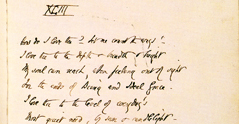WORKING WOMEN IN VICTORIAN BRITAIN, 1850-1910
The Diaries and Letters of Arthur J Munby (1828-1910) and Hannah Cullwick (1833-1909) from Trinity College, Cambridge
Thousands of detailed accounts in diary and letter form offer an almost inexhaustible source of literature for researchers studying Victorian Britain. What did working women talk about? What were their hours of work? What were their wages? What did they like? What did they complain about? We get to know many of the women extremely well. Like Mayhew, Munby draws compelling vignettes, but he also particularises them and packs them with detail. He is just as adept at describing divorce court proceedings, the meeting of a suffrage society, work in a factory or entertainment in a music hall. Hannah Cullwick, a Victorian maid of all work, was Munby's servant. They were married secretly in 1873.
Her life, before and after her marriage, is well documented in this microfilm project. Hannah's own handwritten autobiography (AJM Ms 98.17) and 16 volume diary (AJM Ms 98.1-16) provide Hannah's story in her own words. These materials are complemented by her 850 letters to Munby. They act as a perfect foil to the thousands of interviews recorded by her husband. The Munby diaries are a rich source for information on literary and artistic circles in Victorian Britain. Friends and acquaintances who feature regularly include R D Blackmore, Ruskin, Rossetti, Arthur and Mary Severn, Helen Taylor and Thackeray. An early diary note records one of Munby's meetings with Ruskin: "After luncheon he showed us the pictures round the room - two large Turners in oil, a Sir Joshua/Angelica Kauffman, and several charming W Hunts, and others. propos of a Capital head of a village girl by Hunt, which Ruskin took me aside to look at, I spoke to him of my favourite project - namely that someone ought to paint peasant girls and servant maids as they are -... and so shame the false whitehanded wenches of modern art."
(AJM Ms 1, f.103, Diary for 1859) Other episodes include a walk in the night air with Dickens, discussing realism in fiction, deliberations with the Fawcetts concerning women's rights, and evening meetings of the Gargoyles - a dinner club devoted to the performance of plays. Major figures of the Victorian period who are recorded on the pages of Munby's diaries are: Dr Arnold, Madame Bodichon, Robert Browning, Hartley Coleridge, J A Froude, William Gladstone, Holman Hunt, Charles Kingsley, Sir Edwin Landseer, Harriet Martineau, John Stuart Mill, John Millais, Monckton Milnes, Lord Palmerston, Baden Powell, Algernon Swinburne and Thomas Woolner. Many are met at luncheon, in clubs, at exhibitions, at plays or at political meetings. More than anything else it is probably this aspect of the diaries along with the huge wealth of detail on the poorer sort in society which guarantees that they cannot fail to be interesting (as Austin Dobson argued in The Times as early as 5 February 1910). Typical volumes of the diary are:
Volume 31. 1863. 29pp + 52ff + notes (with index).
There is a list of journeys made and letters written in 1863. Diary entries cover an Army Clothes Factory; Brickmakers; a Brewery and Colliery; a Dustwoman; Female Porters; Field Labour; Milkwomen; Quakers; Mrs Rae; Rossetti and Ruskin. Volume 33. 1865. 32pp + 52ff (with index at the front).
Diary entries relate to a Black Irishwoman; R D Blackmore; Women of British Columbia; Factory Girls; Field Labour; Fishergirls; J A Froude; Harriet Langdon; Milkwomen; Parkhurst Female Prison; Servants; The Severns; a Tatooed woman; A Tennyson and Wigan Pitgirls. These sources have hitherto remained largely unpublished. Derek Hudson's Munby - Man of Two Worlds (John Murray, London, 1972) drew attention to this material, and provided some brief extracts from the diaries and letters. Liz Stanley's The Diaries of Hannah Cullwick, Victorian Maidservant (Virago Press, London, 1984) concentrated purely on Hannah, and in 328 pages could only hope to sample her autobiography and diaries. Michael Hiley's Victorian Working Women: Portraits from Life (Gordon Fraser, London, 1979) featured some of Munby's photographs. Here we offer all of Munby's diaries (64 volumes averaging at least 200 pages each - crammed with detail for gender analyses by the social historian); his 12 notebooks on working women; the 29 volumes of Visits to Hannah; Munby's two volume life of Hannah; 12 further notebooks on Hannah; Hannah's own 16 volume diary; Hannah's autobiography; over 850 letters; the manuscript of Faithful Servants, 2 boxes of manuscript poetry and 7 albums of photographs.
|















